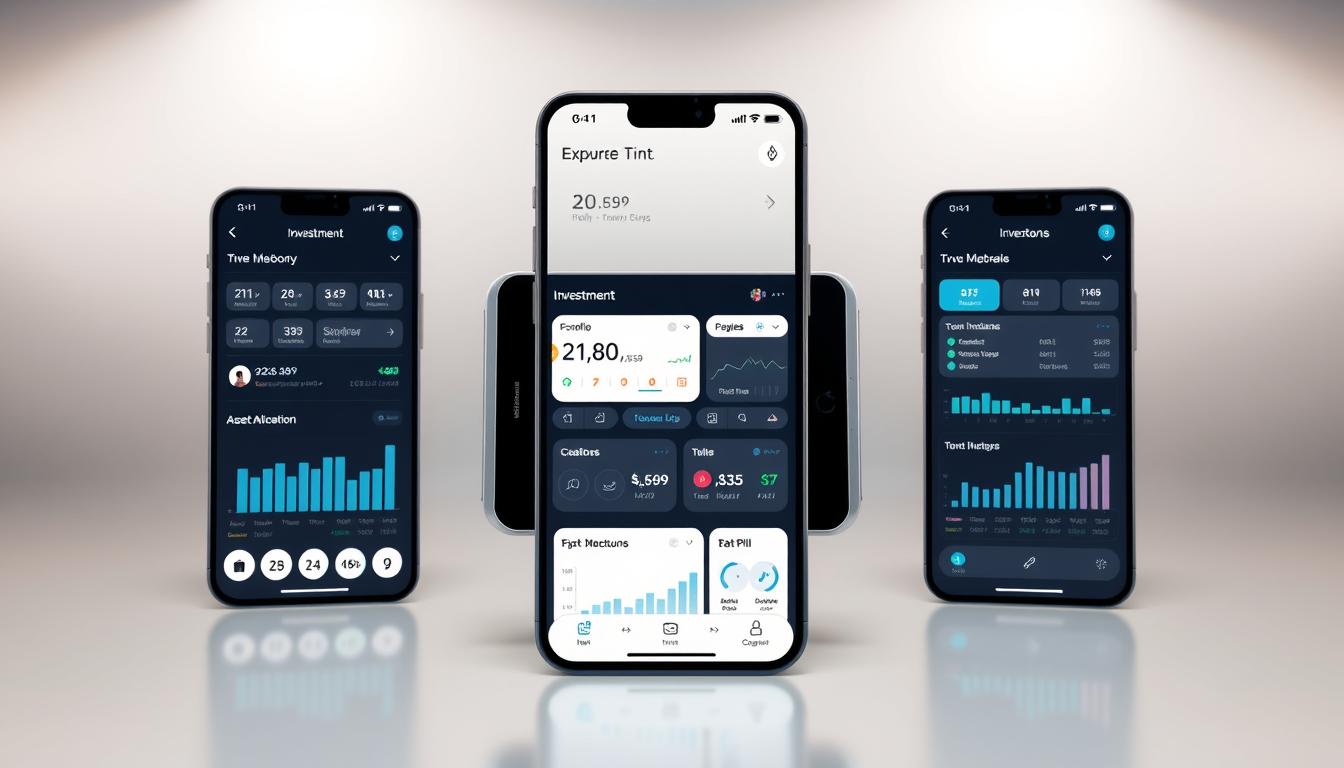Starting to build a portfolio can feel confusing. This guide makes it simpler by comparing top platforms that help beginners learn, trade, and save for retirement with confidence.
We spotlight category leaders — Fidelity (best overall and for retirement), Robinhood (friendly stock trades), Webull (paper trading), Betterment (robo-advisor), Schwab (bonds), Public (Treasury tools), Coinbase (crypto), and more. Each entry notes what the app does well, who benefits most, and which features matter first, such as fractional shares, goal-based portfolios, and SIPC protection.
Expect clear comparisons of fees, account types, research resources, and security basics so you can pick a platform without drowning in jargon. We also explain how market tools like real-time quotes, alerts, and advanced charts support smarter decisions as you learn.
Key Takeaways
- Match platform strengths to your goals: retirement, practice trading, or hands-off portfolios.
- Look for features that lower friction: easy onboarding, fractional shares, and automation.
- Real-time data and alerts help new traders act with more confidence.
- Compare fees, account types, and customer support before committing.
- Security and custody matters — confirm SIPC or equivalent protections.
Investment Apps
Mobile and desktop broker platforms now lower the barrier to entry. They let a new investor open an account, fund it, and place stock or ETF orders with minimal friction. Built-in tools and plain-language tutorials speed the learning curve.
What they are and why beginners use them
These platforms combine onboarding, secure funding, and order entry into one place. Watchlists, screeners, alerts, and educational modules help users evaluate ideas and practice with small trades.
Beginners like clear menus and simple order tickets. That reduces mistakes and builds confidence while the market moves.
Today’s landscape in the United States
Most major U.S. platforms now offer $0 online trades for stocks and ETFs. They differ on mutual funds, crypto access, and bond depth.
“Schwab stands out for bond selection, while robo-advisors like Betterment automate diversified portfolios for low fees.”
- Full-service brokers and mobile-first platforms coexist with robo-advisors and bank-tied offerings.
- Some platforms include options and crypto; others focus on simple stock trading.
- Choose a platform that matches the features you need today—bonds, mutual funds, or digital assets—so you don’t outgrow the interface.
Best investment apps for first-time investors: our top picks and who they’re for
Here are the standout platforms that match common beginner goals and styles. Use this quick guide to find the right app for simple stock trades, practice trading, hands-off portfolios, or bonds and Treasurys.
Fidelity — best overall app and retirement investing for beginners
Fidelity (5.0/5) blends deep research, an intuitive mobile app, and strong retirement tools. New users benefit from expense-ratio-free index funds and high interest on uninvested cash.
Robinhood — best for beginner stock trading and simple UX
Robinhood (4.5/5) offers a streamlined interface for placing a stock order fast. It includes crypto trading and an IRA match, though research tools are limited.
Webull — best for practice stock trading with unlimited paper trading
Webull (5.0/5) is ideal for paper trading and learning order types. Advanced charts and strong execution help traders move from simulation to live trading.
Charles Schwab — best for bond investing and diversified portfolios
Charles Schwab (4.8/5) stands out for bond access and research. U.S. Treasurys trade with $0 commission, making fixed income practical for a new investor.
Betterment — best robo-advisor for hands-off, goal-based investing
Betterment (5.0/5) automates goals and uses fractional shares to keep cash fully invested. Low minimums and planning tools reduce decision fatigue for beginners.
SoFi Active Investing — best for a clean interface and IPO access
SoFi (4.4/5) offers a minimalist UX and occasional IPO access. It’s a simple place to trade core stocks and ETFs without clutter.
Public — best for Treasury accounts and beginner options tools
Public (4.6/5) provides a Treasury account and a friendly Options Hub with rebates. The platform focuses on ease for new users over deep screeners.
Coinbase — best for beginner cryptocurrency trading
Coinbase (4.6/5) is the on-ramp for crypto beginners, with quick withdrawals and low funding minimums. Note fee transparency differs from broker platforms.
J.P. Morgan Self-Directed Investing — best for educational content and Chase integration
J.P. Morgan ties investing to Chase banking, adds in-person support, and delivers strong news and learning resources for new investors.
How to choose the right app for your goals and risk tolerance
Match your personal goals and tolerance for swings to the platform features you’ll use most. That simple step clears up many choices and keeps you focused on tools that matter.
Active trading vs. long-term investing: aligning tools to your strategy
Decide if you want fast trades or steady growth.
Trading-first products prioritize order speed, charts, and options support.
Long-term solutions emphasize goal tracking, automatic deposits, and low behavior-driven risk.
Account types, SIPC coverage, and financial planning features
Pick the account that fits your goal: taxable for general use, Roth or traditional for retirement.
Check SIPC limits: member brokerages cover up to $500,000 of securities (including $250,000 in cash). SIPC does not protect against market losses or many crypto holdings.
Robo-advisors manage ETF portfolios for a fee, while full-service brokers offer broader products and research for deeper financial planning.
Platform usability, customer service, and research quality for new investors
Balance a clean interface with helpful research. Some platforms keep menus lean for clarity; others offer screeners and third-party analysis that aid smart investment decisions.
Good customer support, tutorials, and access to advisors speed learning and lower mistakes for new investors.
- Align platform features with the assets you plan to buy—bonds, mutual funds, or crypto.
- Be honest about your time and risk tolerance; a robo-advisor may suit hands-off goals.
Pricing, fees, and promotions that impact beginner returns
What sounds like free trading can hide small costs that cut into early gains. Read promos and fee schedules closely before picking an app. Promotions can boost your starting balance, but ongoing charges shape long-term returns.
Promotions to know now
Welcome offers include single free stock (Robinhood after bank link), cash matches (Public’s 1% transfer match), and funded-stock bonuses (SoFi’s up to $3,000 for qualifying Active Invest accounts). Webull offers a 2% match up to $1M and an 8.1% APY via Premium on idle cash. Betterment gives up to $1,000 for new funded accounts.
Subscription and management fees
Robo-advisors charge management fees that trade convenience for cost. A low percentage is fine at larger balances. A fixed $4 monthly tier can be costly for small accounts. Match fee structure to your time horizon and balance.
| Cost Area | Typical Charge | Effect on Beginners |
|---|---|---|
| Stock/ETF trades | $0 online | Low friction for basic trading |
| Options | Per-contract fees apply | Can erode small-account gains |
| Crypto | 0%–4% spreads/fees | Opaque costs can surprise frequent traders |
| Bonds | $0 Treasurys; $1 per bond non-Treasury (Schwab) | Better pricing for fixed-income diversification |
“Check fine print: promos help, but long-term fees guide real returns.”
Safety first: security protocols, SIPC protection, and what happens if an app fails
Start by locking down security settings so your account and personal data stay protected.
Two-factor authentication and biometric logins cut the chance of account takeover. Confirm the service hashes passwords and encrypts sensitive information at rest and in transit.
Use unique passwords and a password manager. Avoid public Wi‑Fi for trades and install updates quickly to close security gaps.
How SIPC protection works and what it does not cover
SIPC protects up to $500,000 per customer, including $250,000 in cash, if a SIPC-member brokerage fails. It does not cover market losses or most crypto holdings.
Know the limits: if your holdings exceed SIPC thresholds, consider diversification or separate custody arrangements as part of broader financial planning.
When a brokerage goes out of business
If a firm becomes insolvent, another broker usually acquires or assumes accounts. Positions are moved so users rarely need to re-enter orders or liquidate positions.
Still, review the provider’s privacy policy and incident response plans so you’ll get prompt notice if an event affects your information or service.
- Turn on two-factor and biometrics where available.
- Check SIPC status and understand coverage caps.
- Use strong, unique passwords and avoid public networks for trading.
- Keep contact details current so you receive security alerts fast.
| Security Feature | What to check | User benefit |
|---|---|---|
| Two-factor authentication | SMS, authenticator apps, or biometrics | Reduces account takeover risk |
| Data protection | Encryption and hashed passwords | Keeps personal info safe |
| SIPC coverage | $500,000 total; $250,000 cash | Protects assets if firm is insolvent (not market losses) |
| Failure handling | Account transfer or acquisition | Minimizes trading disruption and preserves holdings |
“Prioritize simple habits—strong passwords, 2FA, and up-to-date apps—to greatly reduce your operational risk.”
What you can invest in with these apps
Different platforms unlock different asset types. Think about the building blocks you want in your portfolio before you pick a platform.
The major full-service brokers (Fidelity, Schwab) offer the widest roster: stocks, ETFs, mutual funds, bonds, options, and fractional shares. Schwab, for example, provides deep bond inventories and $0 Treasurys, which helps with fixed-income diversification.
Stocks, ETFs, mutual funds, bonds, options, and fractional shares
Most mainstream platforms let you buy stocks and ETFs. Many also allow fractional shares so you can invest by dollar amount rather than whole share counts.
If mutual funds and broad bond access matter, choose a full-service platform. Beginners testing options should look for simple tickets and clear education before trading multi-leg strategies.

Crypto, commodities, and global market data
Crypto availability varies widely. Coinbase is built for digital assets, while some broker platforms offer limited crypto or require a separate app. Public provides a Treasury account for cash-like yield backed by the U.S. government.
For market context and cross-asset research, tools like Investing.com supply real-time stock, commodity, currency, bond, and index data even though they aren’t trading platforms. Traders can compare asset classes there to shape allocation choices.
“Choose a platform that supports the specific asset types you plan to hold — that reduces costly account transfers later.”
| Asset type | Typical platform | Beginner fit | Notes |
|---|---|---|---|
| Stocks & ETFs | Fidelity, Robinhood, Webull, Schwab | Very high | Core for most portfolios; fractional shares common |
| Mutual funds | Fidelity, Schwab | High | Better for long-term, tax-smart strategies |
| Bonds & Treasurys | Schwab, Fidelity, Public (Treasury acct) | Moderate | Schwab offers 150,000+ individual bonds and $0 Treasurys |
| Crypto & commodities | Coinbase, select brokers, Investing.com (data) | Variable | Coinbase for trading; Investing.com for market charts |
Real user feedback: what beginners like and dislike about top apps
Hands-on feedback from first-time users highlights practical strengths and recurring friction points. Ratings and comments show patterns that help new users choose a platform that fits their needs.
Fidelity and Schwab
Users praise strong customer service, robust education, and security features. These platforms score high for research and long-term tools.
Common complaints include navigation changes after integrations and a cluttered interface for some users.
Robinhood and Webull
Both earn praise for simple workflows and powerful tools. Robinhood is favored for quick trades; Webull for advanced charting and paper trading.
Negative reviews often note occasional freezes, crashes, or slow identity checks that frustrate new customers.
Betterment and Public
Betterment gets kudos for set-it-and-forget-it automation and a clean onboarding flow. Some users say a flat monthly fee feels steep at small balances.
Public is loved for intuitive design and educational content, plus a Treasury account, though withdrawal delays and sporadic fees appear in ratings.
Coinbase, SoFi, and J.P. Morgan
Coinbase is praised for ease of use and crypto learning rewards, but users flag higher, less-transparent fees and support gaps.
SoFi’s bundled banking and rewards attract users, yet cross-selling and occasional app freezes are common gripes. J.P. Morgan benefits from Chase integration and approachable investing features.
“An app’s strengths—education, simplicity, or advanced tools—often come with trade-offs like UI changes or support delays.”
- Tip: Check recent ratings and support response times before you open an account.
- Tip: Match platform features to your comfort level with the stock market and crypto exposure.
Tools that help beginners make smarter investment decisions
Good market trackers give beginners a clear signal when a price move matters and when it doesn’t.
Real-time data, alerts, and advanced charts show trends, support and resistance, and volume so new traders can spot momentum or hesitation.
Custom alerts notify you when a stock hits a target or when news affects a sector, letting you act in your chosen app without watching screens all day.

Economic calendars, expert analysis, and community insights
An economic calendar highlights central bank moves, jobs reports, and inflation prints that often sway the stock market.
Expert analysis condenses complex developments into clear takeaways, while technical tools and screeners narrow candidates that fit your portfolio rules.
Community threads and social features let traders compare views and learn different approaches, adding context to raw price moves.
“Use external trackers to see cross-asset signals—commodities, bonds, and currencies—before you place trades.”
- Tip: Sync watchlists and alerts to reduce noise and prioritize decisions.
- Tip: Keep notes on catalysts and outcomes to create a feedback loop that improves decision quality.
Tax, costs, and other factors new investors often overlook
A small oversight in cash management or trade timing can produce a big tax bill. New users should track how trades, fees, and idle cash work together. That helps avoid unpleasant surprises at year-end.
Capital gains and trading frequency
Capital gains, trading frequency, and year-end surprises
Selling positions at a profit triggers tax. Short-term gains are taxed as ordinary income, so frequent trading can increase your bill.
Use an app’s cost-basis tools and year-end tax documents to forecast liabilities. Hold winners past one year when possible to reduce tax drag.
Interest rate on uninvested cash and cash management choices
Compare the interest rate paid on idle cash and how your provider sweeps funds. Some platforms boost APY for premium tiers (Webull Premium is an example), which can add up while you build positions.
Fractional-share investing lets you add small amounts regularly. But set rules so contributions support your plan, not market timing.
- Plan: Align investment decisions with your time horizon and financial planning goals.
- Track: Use tax tools in the app to estimate gains before December.
- Avoid: Overtrading on headlines; periodic rebalancing beats chasing moves.
“Be mindful: fees, sweep rates, and realized gains shape your net returns more than one-off wins.”
Conclusion
, Start with one easy-to-use app and focus on steady learning. Small trades, watchlists, and time-tested rules teach execution and risk control without friction.
Choose a platform that fits your goals: Fidelity for retirement and research, Robinhood or Webull for simple stock trading and practice, Schwab for bonds, and Betterment for hands-off portfolios. Coinbase and Public serve crypto and Treasury needs.
Promotions can boost your start, but long-term fit—fees, interest rate on idle cash, features, and support—should decide where you keep your money. Use small shares and alerts to build confidence, then scale your portfolio over time.
Bottom line: pick one app, learn by doing, and let the platform earn your trust as your needs evolve.
FAQ
What are investing platforms and why do beginners use them?
Investing platforms are services that let users buy and sell stocks, ETFs, bonds, and crypto from a smartphone or web browser. Beginners choose them for easy account setup, educational tools, low minimums, and features like fractional shares that let you start with small amounts.
How does the current U.S. market landscape affect new investors?
Volatility and higher interest rates mean cautious portfolio construction matters more. New investors should focus on diversification, low-cost funds, and long-term goals while using tools like paper trading and research to learn without large risks.
Which platforms are best for beginners and what makes each one stand out?
Fidelity is a strong all-around choice with deep research and retirement tools. Robinhood offers a simple user interface for stock trading. Webull provides unlimited paper trading for practice. Charles Schwab is solid for bonds and diversified portfolios. Betterment is a top robo-advisor for goal-based, hands-off strategies. SoFi features a clean interface and IPO access. Public emphasizes community features and Treasurys. Coinbase is focused on crypto. J.P. Morgan Self-Directed fits those who want Chase banking integration and educational content.
Should I trade actively or build a long-term portfolio?
That depends on your goals and time horizon. Active trading can lead to higher costs and tax events; it suits experienced users who can devote time to research. Long-term investing with diversified funds typically lowers fees and tax drag and matches retirement and wealth-building goals better for most beginners.
What account types should I consider and is my money protected?
Look at taxable brokerage accounts, traditional and Roth IRAs, and custodial accounts for minors. Most brokerages provide SIPC protection for securities and cash held at the firm up to limits; check whether cash sweep programs carry FDIC coverage and read each platform’s terms.
What fees should new investors watch for?
Watch management fees for robo-advisors, margin interest, options contract fees, and transfer or inactivity charges. Also compare APY on uninvested cash and promotional offers like free shares or cash matches, which can affect early returns.
How secure are these platforms and what security steps should I take?
Leading platforms use encryption, two-factor authentication, and account alerts. You should enable 2FA, use strong unique passwords, monitor account activity, and verify electronic communications to reduce phishing risks.
What happens if a brokerage fails?
If a SIPC-member brokerage fails, SIPC helps recover missing securities and cash up to limits; it does not protect against market losses. Some customers have additional protections through private insurers. Keep records and contact the firm or SIPC for guidance if issues arise.
What asset types can I buy on these platforms?
Most let you trade stocks, ETFs, mutual funds, bonds, options, Treasurys, and fractional shares. Many also offer crypto, commodities exposure via ETFs, and access to global market data depending on the provider.
How do tools like paper trading and alerts help beginners?
Paper trading lets you practice order types and strategies without real money. Real-time alerts, advanced charts, and economic calendars help you learn market reactions and make more informed decisions before committing capital.
What tax and cost issues do beginners often miss?
New users often overlook capital gains from frequent trading, wash-sale rules when selling at a loss, and the tax treatment of crypto. Also compare interest rates on uninvested cash and fees tied to account transfers or margin usage.
How do promotions like free stock or cash matches work?
Promotions vary: some platforms grant a free fractional share for referrals or deposits, while others offer cash matches on contributions for short periods. Read terms carefully for holding requirements, withdrawal limits, and tax implications.
Can I access educational content and financial planning tools on these platforms?
Yes. Many providers offer learning centers, webinars, and calculators. Robo-advisors like Betterment include goal-based planning, while brokers such as Fidelity and J.P. Morgan provide robust research and guidance for retirement and portfolio construction.
Are fractional shares and Treasury options available to beginners?
Fractional shares are widely available and help investors buy expensive stocks with limited funds. Treasury purchases and short-term Treasury accounts are also offered by several platforms, useful for conservative cash management.
How should I pick the right platform for my needs?
Match features to your goals: choose strong research and retirement tools for long-term saving, a simple UI for ease of use, paper trading if you want practice, and transparent fees if cost matters most. Also verify customer service quality and mobile experience before committing.

